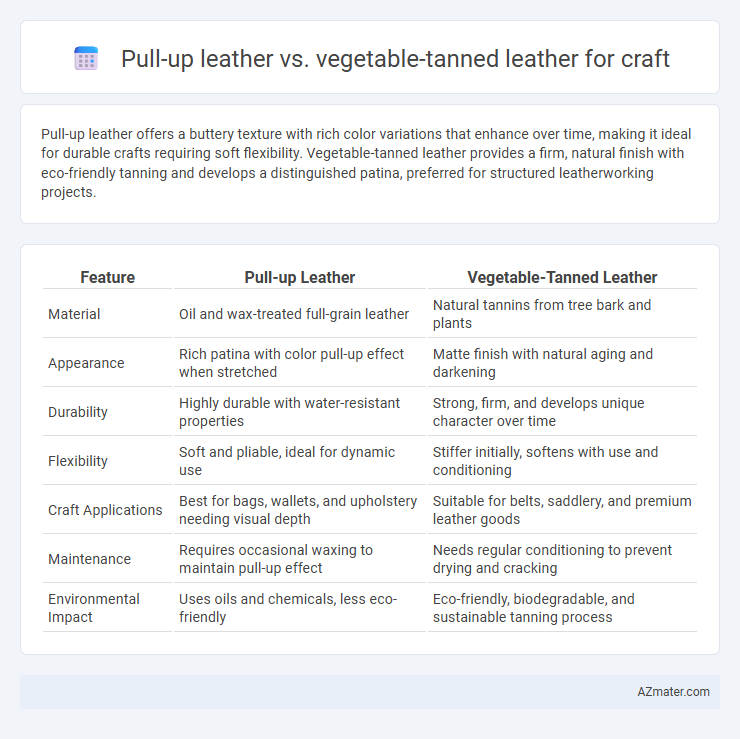Pull-up leather offers a buttery texture with rich color variations that enhance over time, making it ideal for durable crafts requiring soft flexibility. Vegetable-tanned leather provides a firm, natural finish with eco-friendly tanning and develops a distinguished patina, preferred for structured leatherworking projects.
Table of Comparison
| Feature | Pull-up Leather | Vegetable-Tanned Leather |
|---|---|---|
| Material | Oil and wax-treated full-grain leather | Natural tannins from tree bark and plants |
| Appearance | Rich patina with color pull-up effect when stretched | Matte finish with natural aging and darkening |
| Durability | Highly durable with water-resistant properties | Strong, firm, and develops unique character over time |
| Flexibility | Soft and pliable, ideal for dynamic use | Stiffer initially, softens with use and conditioning |
| Craft Applications | Best for bags, wallets, and upholstery needing visual depth | Suitable for belts, saddlery, and premium leather goods |
| Maintenance | Requires occasional waxing to maintain pull-up effect | Needs regular conditioning to prevent drying and cracking |
| Environmental Impact | Uses oils and chemicals, less eco-friendly | Eco-friendly, biodegradable, and sustainable tanning process |
Introduction to Pull-Up Leather and Vegetable-Tanned Leather
Pull-up leather is a type of aniline leather treated with natural oils and waxes, giving it a distinct distressed look and excellent durability for crafts. Vegetable-tanned leather undergoes a traditional tanning process using natural tannins from tree bark, resulting in a firm, eco-friendly material prized for its aging and patina development. Both leathers are favored by artisans for their unique textures and ability to be handcrafted into high-quality leather goods.
Defining Pull-Up Leather: Characteristics and Uses
Pull-up leather is a type of full-grain leather treated with natural oils and waxes that create a distinctive color shift when stretched or pulled, enhancing its rugged aesthetic and patina over time. This leather is prized in craft projects for its durability, softness, and ability to develop unique creases that highlight the handcrafted nature of products like bags, wallets, and belts. Its water-resistant properties and vintage appeal make pull-up leather ideal for artisanal goods requiring both functionality and a rich, lived-in look.
What is Vegetable-Tanned Leather? Features and Applications
Vegetable-tanned leather is crafted using natural tannins extracted from tree bark, leaves, and other plant materials, resulting in a durable, firm, and eco-friendly hide that ages beautifully with a rich patina over time. This type of leather is highly valued in craft for its stiffness, ability to be tooled or embossed, and natural earthy color variations that deepen with use. Common applications include high-quality belts, wallets, saddlery, and artisanal bags where durability and aesthetic development are essential.
Tanning Processes: Pull-Up vs. Vegetable-Tanned Leather
Pull-up leather undergoes aniline tanning with additional oils and waxes applied to create a supple, distressed finish that enhances color variation when stretched or bent. Vegetable-tanned leather is tanned naturally using tannins derived from tree bark, resulting in a firmer, more rigid material that develops a rich patina over time. The tanning process of pull-up leather prioritizes flexibility and vintage appeal, while vegetable tanning emphasizes durability and natural aging characteristics ideal for craft projects.
Appearance and Color: Visual Differences Explained
Pull-up leather exhibits a rich, distressed look with natural variations in color intensity caused by the wax or oil finish that shifts when flexed. Vegetable-tanned leather reveals a more uniform, matte appearance with warm, earthy tones that deepen and develop a patina over time through oxidation and exposure to sunlight. These visual differences make pull-up leather ideal for vintage-style crafts, while vegetable-tanned leather suits projects valuing natural aging and classic aesthetics.
Durability and Aging: How Each Leather Evolves Over Time
Pull-up leather, treated with oils and waxes, offers exceptional durability and develops a rich, patinated finish as it ages, revealing lighter streaks with use and bending. Vegetable-tanned leather, crafted using natural tannins, becomes sturdier and gains a deep, warm hue over time, showcasing unique character marks and a natural sheen from daily wear. Both leathers improve in appearance and strength with age, but pull-up leather is more resistant to scratches while vegetable-tanned leather offers a more traditional aging process.
Workability: Which Leather is Better for Crafting?
Pull-up leather, known for its supple, flexible nature and unique color-changing properties when stretched, offers exceptional workability for crafting projects requiring a more malleable material. Vegetable-tanned leather, while stiffer and less flexible, provides superior structure and hold, ideal for detailed tooling, carving, and shaping. For artisans prioritizing ease of folding, molding, and quick shaping, pull-up leather is better, whereas vegetable-tanned leather excels in durability and intricate craftsmanship.
Environmental Impact: Sustainability Considerations
Pull-up leather undergoes heavy oiling and waxing, enhancing durability but often involving synthetic chemicals that may affect biodegradability. Vegetable-tanned leather uses natural tannins from plant sources, offering a more eco-friendly and biodegradable option with lower environmental pollution. For sustainable crafting, vegetable-tanned leather is generally preferred due to its renewable tanning materials and reduced chemical footprint.
Price Comparison: Pull-Up Leather vs. Vegetable-Tanned Leather
Pull-up leather typically commands a higher price due to its unique wax treatment and rich, distressed appearance that develops character over time. Vegetable-tanned leather, while often more affordable, offers durability and a natural patina that appeals to traditional crafters seeking authentic aging. Comparing prices, pull-up leather may cost 20-30% more per square foot than vegetable-tanned leather, making budget considerations crucial for large-scale projects.
Choosing the Right Leather for Your Craft Project
Pull-up leather offers a supple texture with a rich patina that improves with use, making it ideal for projects requiring durability and a vintage look. Vegetable-tanned leather provides a firm structure and ages beautifully, perfect for crafts demanding precision and natural finishes. Selecting the right leather depends on the desired flexibility, aging characteristics, and final application of your craft project.

Infographic: Pull-up leather vs Vegetable-tanned leather for Craft
 azmater.com
azmater.com